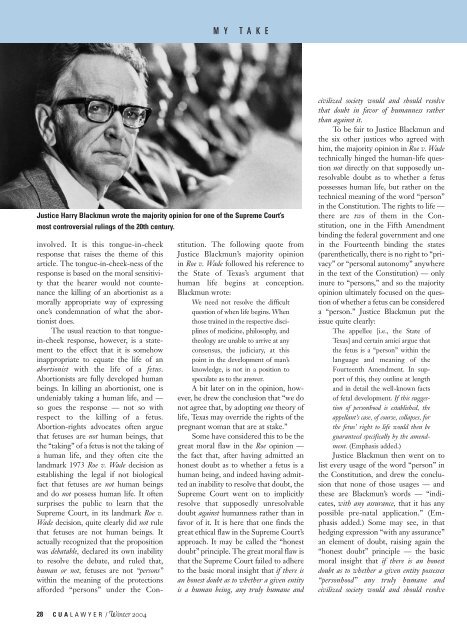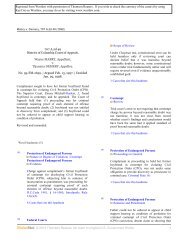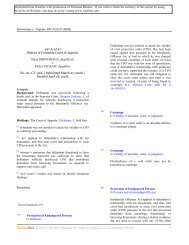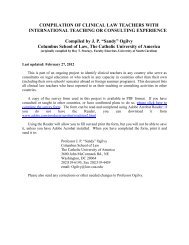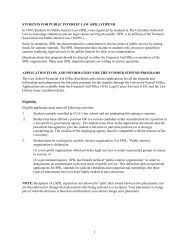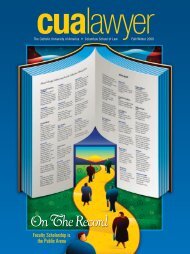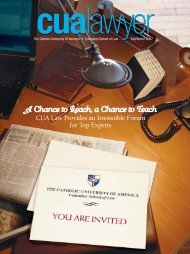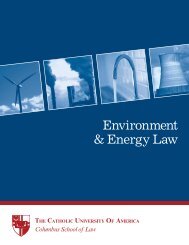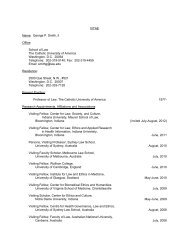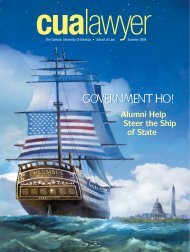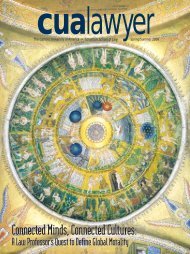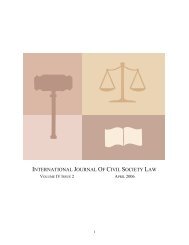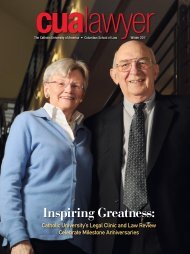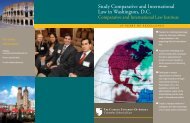CUA Cover Winter 2004 final (Page 2) - Columbus School of Law
CUA Cover Winter 2004 final (Page 2) - Columbus School of Law
CUA Cover Winter 2004 final (Page 2) - Columbus School of Law
- No tags were found...
You also want an ePaper? Increase the reach of your titles
YUMPU automatically turns print PDFs into web optimized ePapers that Google loves.
M Y T A K EJustice Harry Blackmun wrote the majority opinion for one <strong>of</strong> the Supreme Court’smost controversial rulings <strong>of</strong> the 20th century.involved. It is this tongue-in-cheekresponse that raises the theme <strong>of</strong> thisarticle. The tongue-in-cheek-ness <strong>of</strong> theresponse is based on the moral sensitivitythat the hearer would not countenancethe killing <strong>of</strong> an abortionist as amorally appropriate way <strong>of</strong> expressingone’s condemnation <strong>of</strong> what the abortionistdoes.The usual reaction to that tonguein-cheekresponse, however, is a statementto the effect that it is somehowinappropriate to equate the life <strong>of</strong> anabortionist with the life <strong>of</strong> a fetus.Abortionists are fully developed humanbeings. In killing an abortionist, one isundeniably taking a human life, and —so goes the response — not so withrespect to the killing <strong>of</strong> a fetus.Abortion-rights advocates <strong>of</strong>ten arguethat fetuses are not human beings, thatthe “taking” <strong>of</strong> a fetus is not the taking <strong>of</strong>a human life, and they <strong>of</strong>ten cite thelandmark 1973 Roe v. Wade decision asestablishing the legal if not biologicalfact that fetuses are not human beingsand do not possess human life. It <strong>of</strong>tensurprises the public to learn that theSupreme Court, in its landmark Roe v.Wade decision, quite clearly did not rulethat fetuses are not human beings. Itactually recognized that the propositionwas debatable, declared its own inabilityto resolve the debate, and ruled that,human or not, fetuses are not “persons”within the meaning <strong>of</strong> the protectionsafforded “persons” under the Constitution.The following quote fromJustice Blackmun’s majority opinionin Roe v. Wade followed his reference tothe State <strong>of</strong> Texas’s argument thathuman life begins at conception.Blackmun wrote:We need not resolve the difficultquestion <strong>of</strong> when life begins. Whenthose trained in the respective disciplines<strong>of</strong> medicine, philosophy, andtheology are unable to arrive at anyconsensus, the judiciary, at thispoint in the development <strong>of</strong> man’sknowledge, is not in a position tospeculate as to the answer.A bit later on in the opinion, however,he drew the conclusion that “we donot agree that, by adopting one theory <strong>of</strong>life, Texas may override the rights <strong>of</strong> thepregnant woman that are at stake.”Some have considered this to be thegreat moral flaw in the Roe opinion —the fact that, after having admitted anhonest doubt as to whether a fetus is ahuman being, and indeed having admittedan inability to resolve that doubt, theSupreme Court went on to implicitlyresolve that supposedly unresolvabledoubt against humanness rather than infavor <strong>of</strong> it. It is here that one finds thegreat ethical flaw in the Supreme Court’sapproach. It may be called the “honestdoubt” principle. The great moral flaw isthat the Supreme Court failed to adhereto the basic moral insight that if there isan honest doubt as to whether a given entityis a human being, any truly humane andcivilized society would and should resolvethat doubt in favor <strong>of</strong> humanness ratherthan against it.To be fair to Justice Blackmun andthe six other justices who agreed withhim, the majority opinion in Roe v. Wadetechnically hinged the human-life questionnot directly on that supposedly unresolvabledoubt as to whether a fetuspossesses human life, but rather on thetechnical meaning <strong>of</strong> the word “person”in the Constitution. The rights to life —there are two <strong>of</strong> them in the Constitution,one in the Fifth Amendmentbinding the federal government and onein the Fourteenth binding the states(parenthetically, there is no right to “privacy”or “personal autonomy” anywherein the text <strong>of</strong> the Constitution) — onlyinure to “persons,” and so the majorityopinion ultimately focused on the question<strong>of</strong> whether a fetus can be considereda “person.” Justice Blackmun put theissue quite clearly:The appellee [i.e., the State <strong>of</strong>Texas] and certain amici argue thatthe fetus is a “person” within thelanguage and meaning <strong>of</strong> theFourteenth Amendment. In support<strong>of</strong> this, they outline at lengthand in detail the well-known facts<strong>of</strong> fetal development. If this suggestion<strong>of</strong> personhood is established, theappellant’s case, <strong>of</strong> course, collapses, forthe fetus’ right to life would then beguaranteed specifically by the amendment.(Emphasis added.)Justice Blackmun then went on tolist every usage <strong>of</strong> the word “person” inthe Constitution, and drew the conclusionthat none <strong>of</strong> those usages — andthese are Blackmun’s words — “indicates,with any assurance, that it has anypossible pre-natal application.” (Emphasisadded.) Some may see, in thathedging expression “with any assurance”an element <strong>of</strong> doubt, raising again the“honest doubt” principle — the basicmoral insight that if there is an honestdoubt as to whether a given entity possesses“personhood” any truly humane andcivilized society would and should resolve28<strong>CUA</strong>LAWYER /<strong>Winter</strong> <strong>2004</strong>


